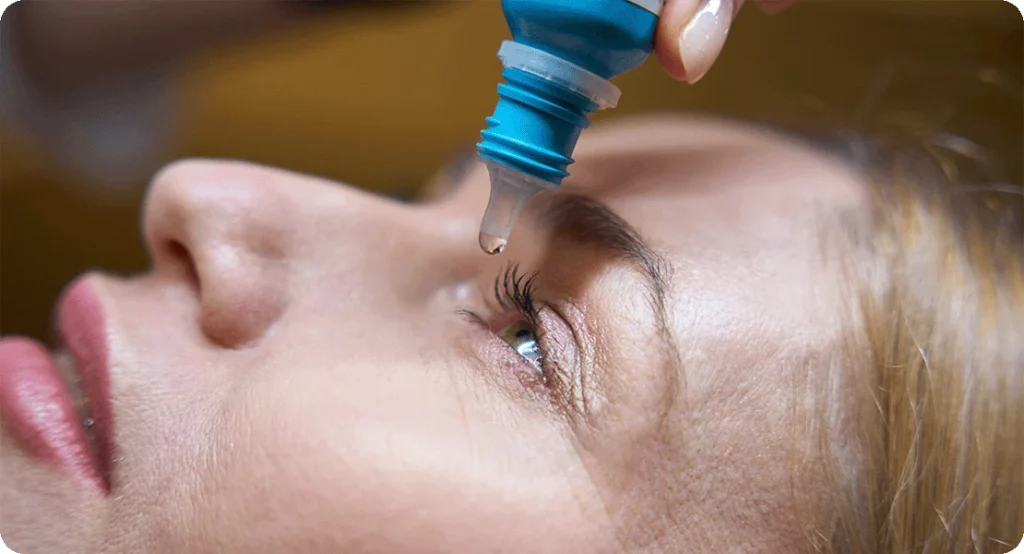Cataract surgery is a common and highly successful procedure that restores clear vision by replacing a clouded lens with an artificial intraocular lens (IOL). While the operation itself is quick and typically performed as a day procedure, the recovery period is crucial for ensuring the best possible outcome. Here’s a detailed guide on what to expect during the cataract recovery process.
Immediate Post-Surgery Care
Once the surgery is complete, you will be taken to a recovery area where your eye will be monitored for a short period. Most patients can go home within a couple of hours, but you will need someone to drive you as your vision may be blurry.
Your surgeon will provide a protective eye shield, which should be worn as instructed, especially while sleeping, to prevent accidental rubbing or pressure on the eye.
Common Immediate Side Effects
- Blurred or cloudy vision – This is normal and usually improves within a few hours to a few days. Your eye is adjusting to the new lens, and temporary swelling or mild inflammation may contribute to the initial blurriness. Some patients describe their vision as foggy or hazy, but this should gradually clear as healing progresses.
- Mild discomfort or a gritty sensation – It is common to feel as if there is something in the eye, similar to having an eyelash or grain of sand trapped. This sensation is typically due to the tiny incision made during surgery and should subside within a day or two. Lubricating eye drops may help ease the discomfort.
- Sensitivity to light – Your eye may be more sensitive to bright light or glare immediately after surgery. This happens because the newly implanted lens allows more light to enter the eye, and the brain needs time to adjust. Wearing sunglasses, particularly outdoors, can provide relief and protect your eye from excessive light exposure.
- Watery eyes or mild redness – Some patients experience excessive tearing or a bloodshot appearance in the eye, which is usually a reaction to the surgery itself. This typically resolves within a week as the eye stabilises. If redness persists or worsens, it is important to consult your ophthalmologist.
- Seeing halos or glare around lights – Some patients report seeing halos around lights, particularly at night. This is usually temporary and diminishes as the eye adapts to the intraocular lens.
- Mild headache or eye strain – While uncommon, some people may experience a mild headache due to changes in vision and eye strain. Resting and keeping screen time to a minimum in the first few days can help alleviate this.
The First Few Days After Surgery
The first few days following cataract surgery are critical for initial healing. It is essential to follow your ophthalmologist’s aftercare instructions, which may include:
- Using prescribed eye drops – These help prevent infection and reduce inflammation. It is crucial to follow the dosage schedule precisely, as skipping applications can increase the risk of complications.
- Avoiding strenuous activities – No heavy lifting, bending over, or intense exercise. Straining can increase pressure inside the eye, which may interfere with healing.
- Keeping water out of the eye – Be cautious while showering or washing your face to prevent irritation. Consider using a protective eye shield or keeping your eyes closed to avoid accidental exposure to water or shampoo.
- Not rubbing or touching the eye – This can cause complications and slow healing. If your eye feels itchy, resist the urge to touch it and instead use lubricating drops as recommended by your doctor.
- Limiting screen time – Extended periods of reading, watching television, or using digital devices can cause eye strain. It’s best to take frequent breaks and allow your eyes to rest during the initial recovery phase.
- Sleeping with an eye shield – Your surgeon may advise wearing an eye shield while sleeping for the first few nights to prevent accidental rubbing or pressure on the eye.
- Avoiding alcohol and smoking – Alcohol can contribute to dehydration, which may slow down recovery, while smoking can increase the risk of complications and prolong healing.

Most people notice significant improvements in their vision within a few days, though some may experience fluctuations in clarity as the eye adjusts to the new lens. It is common for vision to continue improving over several weeks, and colours may appear brighter or sharper than before the surgery. However, patience is key, as each person’s recovery timeline may vary.
One to Two Weeks Post-Surgery
By the end of the first week, discomfort should have significantly reduced, and vision should continue to stabilise. However, it is still essential to be cautious:
- Avoid swimming, hot tubs, and saunas to prevent infections – Water in these environments contains bacteria that could lead to an eye infection. It is best to wait at least two weeks before engaging in such activities, or until your ophthalmologist confirms it is safe. Even after two weeks, wearing protective goggles while swimming can add an extra layer of precaution. Chlorinated pools can also cause irritation, so if you must swim, keep your eyes closed underwater and rinse them with sterile saline afterward.
- Continue wearing your eye shield at night – Even if your eye feels better, accidental rubbing or pressure during sleep could disrupt healing. Keeping the shield on for the recommended duration ensures added protection. If you frequently turn in your sleep, securing the shield with medical tape can prevent it from shifting. It’s especially important for those who tend to sleep on the side of the operated eye.
- Refrain from wearing eye makeup to reduce the risk of contamination – Cosmetics can introduce bacteria to the healing eye. If necessary, wait at least two weeks before resuming makeup use, and ensure brushes and applicators are thoroughly cleaned before application. Opt for hypoallergenic products to minimise irritation once you resume wearing makeup. When applying or removing makeup, avoid tugging on the eyelid or getting any product near the eye to prevent irritation.
- Be mindful of environmental irritants – Wind, dust, and pollen can cause irritation and excessive tearing. If you need to go outside, wearing protective sunglasses can help shield your eye from these elements. Avoid areas with heavy pollution or strong fumes, as these can further aggravate healing eyes. Indoors, ensure rooms are well-ventilated but avoid direct exposure to fans or air conditioning vents that may blow dust or dry air into your eye.
- Monitor for any unusual symptoms – While mild discomfort and slight blurriness are normal, symptoms such as sudden pain, increased redness, or flashes of light should be reported to your doctor immediately. Prolonged light sensitivity or excessive floaters could indicate underlying issues that require prompt medical attention. Additionally, a sudden increase in eye pressure, which may cause severe headache or nausea, should be assessed by a specialist as soon as possible.
- Gradual resumption of physical activities – Most patients can return to non-strenuous activities within a week, such as watching television, reading, and using a computer. However, more demanding physical activities such as jogging, weightlifting, or yoga involving head-down postures should be avoided for at least two weeks to prevent any strain on the eye. Walking is generally encouraged as a light form of exercise, but avoid dusty or windy outdoor conditions that may introduce irritants to the eye.
- Assessing readiness for driving – While some individuals may feel confident resuming driving after a week, others may still experience glare, light sensitivity, or fluctuating vision. It is best to wait until your ophthalmologist confirms that your vision meets the legal standard before getting behind the wheel. If you feel hesitant, start with short daytime drives before progressing to night-time driving. Avoid busy roads at first, as your depth perception and ability to judge distances may take time to fully adjust.
- Adapting to visual changes – If you had cataract surgery in only one eye, you may experience a temporary imbalance in vision between the treated and untreated eye. This can affect depth perception and coordination. If you have difficulty adjusting, it may take time for your brain to adapt, or your ophthalmologist may recommend prescription lenses for balance. Some patients find that wearing their previous glasses with only one lens removed can help during the adjustment period. If necessary, your doctor may suggest temporary corrective lenses until both eyes are balanced.

While vision should be stabilising by this stage, full recovery and adaptation to the intraocular lens can take several weeks. Following all post-operative care instructions will help ensure the best possible outcome and reduce the risk of complications.
One Month and Beyond
By four weeks, most patients experience full recovery with clear and stable vision. Any residual blurriness should have resolved, though some individuals may still need reading glasses or further vision correction. The brain and eyes continue to adapt to the new intraocular lens, and any lingering visual disturbances, such as mild glare or halos around lights, typically diminish over time.
For those who opted for multifocal or toric lenses, there may be a period of neuroadaptation, where the brain learns to process the new way light enters the eye. This adjustment can take several weeks or even months for some individuals. Patients who had surgery in both eyes may notice improved depth perception and a more natural field of vision as their brain fully integrates the changes.
Your ophthalmologist will schedule a follow-up appointment to assess your recovery and determine if any additional treatments, such as a new prescription for glasses, are needed. If vision is not as sharp as expected, further assessments may be conducted to check for residual refractive errors or minor astigmatism, which can often be corrected with eyeglasses or, in some cases, laser enhancement procedures.
It is also important to continue practising good eye care habits even after full recovery. Protecting your eyes from excessive UV exposure by wearing sunglasses, staying hydrated, and maintaining a healthy diet rich in antioxidants and omega-3 fatty acids can help support long-term eye health. Regular eye exams beyond the immediate post-surgery period will help monitor for any age-related vision changes or potential complications that may arise over time.
Potential Complications
While cataract surgery is generally safe, there are some potential complications to be aware of:
- Persistent blurriness or vision problems – While most patients regain clear vision, some may experience ongoing blurriness due to residual swelling, dry eyes, or minor refractive errors. If this does not improve with time, your ophthalmologist may recommend additional tests to identify the underlying cause and discuss corrective options.
- Infection or inflammation – Though rare, an infection inside the eye (endophthalmitis) or severe inflammation can occur. Symptoms include increasing eye pain, significant redness, swelling, or sudden vision loss. Immediate medical attention is required to prevent complications and ensure a full recovery.
- Posterior capsule opacification (PCO) – Sometimes referred to as a ‘secondary cataract’, this occurs when the membrane behind the implanted lens becomes cloudy, affecting vision. PCO can develop months or even years after surgery but is easily treated with a quick and painless laser procedure called YAG laser capsulotomy, which restores clear vision within minutes.
- Light sensitivity or glare issues – Some individuals may continue to experience sensitivity to bright lights or notice glare and halos around lights, especially at night. This usually improves over time, but if it persists, your ophthalmologist may recommend anti-glare coatings for glasses or additional adjustments.
- Macular oedema – A build-up of fluid in the macula (the central part of the retina) can cause central vision to appear blurry or distorted. This is usually treated with anti-inflammatory eye drops or, in some cases, injections to reduce swelling.
- Retinal detachment – A rare but serious complication where the retina pulls away from the back of the eye, leading to sudden vision changes, flashes of light, or a shadow over part of the visual field. Immediate medical intervention is required to prevent permanent vision loss.
- Dysphotopsia (unwanted visual effects) – Some patients report seeing arcs of light, shadows, or streaks in their peripheral vision after surgery. While these effects often diminish over time, in rare cases, they may require additional treatment if they significantly impact daily activities.
Most complications are rare, and the vast majority of patients experience significant vision improvement without issues. However, staying vigilant for any unusual symptoms and attending all scheduled follow-up appointments will help ensure the best possible outcome and long-term eye health.

Final Thoughts
Cataract surgery recovery is generally smooth, with most people regaining clear vision within a few weeks. By following post-operative care instructions and attending follow-up appointments, you can ensure optimal healing and enjoy the long-term benefits of your improved eyesight.
If you have any concerns during your recovery, it is always best to contact your ophthalmologist for advice. Proper care and patience will help you achieve the best possible outcome from your cataract surgery.

